| The recent upturn in the Canadian dollar has been more marked than in the early 1990s, which led to a sharp increase in cross-border shopping by Canadians in the US.
At that time, the surge in same-day auto trips to the US aggravated the weakness in consumer spending in Canada, which was slumping due to recession and the recently instituted GST. It also considerably worsened Canada’s international travel deficit. The downturn in the dollar beginning in 1992 ended these trends.
However, even with the loonie at 84 cents (US) in November, Canadian consumers have not shown a greater inclination to cross the border to shop. Canada has been very much like the rest of the world in shunning the US as a destination, despite the surge in several other major currencies against the US dollar.
These developments occurred despite a surge in the number of global travellers since 1990, another manifestation of globalisation, led by Asia as both source and destination. This was reflected by visitors shifting to Western Canada as a destination. By 2004, BC saw almost as many overseas visitors as Ontario. BC was the only region to have a net inflow of overseas travel. Ontario had the largest net outflow as its residents increasingly travelled abroad.
Figure 1
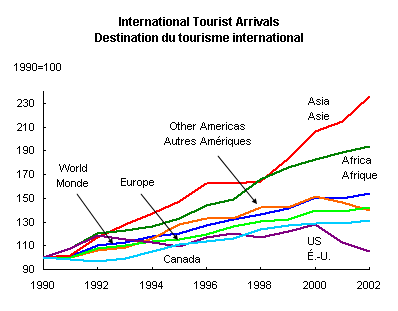
Cross-border shoppers have not responded to the loonie
Visits by Canadians to the US have generally moved in tandem with the exchange rate. When the dollar depreciated after 1992, trips south of the border fell 55% to only 35.9 million. This drop was driven by fewer same-day auto trips – a widely used measure of cross-border shopping.
However, since 2002 the close relationship between the dollar and Canadians traveling to the US has broken down (Figure 2). The loonie has risen in value, but for the first time in 20 years the number of Canadians travelling south of the border has not responded.
Figure 2

The recent increase in Canada’s exchange rate has been even stronger than during 1986-91. But the only observable impact has been to discourage Americans from travelling to Canada, although some of this decline is also part of the negative fallout from the September 11 attacks.
Table 1: Travellers, by origin and destination
| |
Canadian Travellers |
Travellers to Canada |
| |
Total |
To US |
Same day by auto |
Overseas |
Total |
From US |
Same day by auto |
From overseas |
| |
millions |
| 1991 |
82.2 |
79.4 |
59.1 |
2.8 |
36.8 |
33.6 |
19.8 |
3.2 |
| 1992 |
79.8 |
76.7 |
57.0 |
3.1 |
35.7 |
32.4 |
19.0 |
3.3 |
| 1993 |
70.0 |
66.7 |
48.3 |
3.3 |
36.1 |
32.6 |
19.0 |
3.5 |
| 1994 |
57.7 |
54.3 |
38.2 |
3.4 |
38.7 |
34.9 |
20.7 |
3.8 |
| 1995 |
55.7 |
52.2 |
36.4 |
3.5 |
41.7 |
37.3 |
22.7 |
4.3 |
| 1996 |
56.4 |
52.7 |
36.3 |
3.7 |
43.3 |
38.5 |
23.8 |
4.8 |
| 1997 |
54.9 |
50.9 |
34.8 |
4.0 |
45.1 |
40.5 |
25.3 |
4.6 |
| 1998 |
47.0 |
42.8 |
28.4 |
4.2 |
48.1 |
43.9 |
27.1 |
4.2 |
| 1999 |
46.4 |
42.2 |
27.1 |
4.3 |
49.1 |
44.6 |
27.3 |
4.4 |
| 2000 |
47.2 |
42.7 |
27.1 |
4.5 |
48.6 |
44.0 |
26.6 |
4.6 |
| 2001 |
43.2 |
38.4 |
24.0 |
4.8 |
47.1 |
42.9 |
25.3 |
4.3 |
| 2002 |
39.2 |
34.6 |
20.9 |
4.7 |
44.9 |
40.9 |
22.8 |
4.0 |
| 2003 |
39.2 |
34.2 |
20.9 |
5.1 |
38.9 |
35.5 |
19.6 |
3.4 |
| 2004* |
41.6 |
35.9 |
21.4 |
5.7 |
38.6 |
34.6 |
17.9 |
4.0 |
| *The first 11 months annualized. |
|
Overall, the number of Americans travelling to Canada fell after 2000, offsetting most of the 33% increase between 1991 and 1999. Between 1991 to 2004, the number of American visitors edged up only 3.0% to 34.6 million.
The drop in cross-border shopping by Canadians was reflected in a marked improvement in the international travel account in the balance of payments. Our travel deficit retreated from a record shortfall of $1.9 billion in 1991—equal to about one-third of our overall current account deficit – to $930 million in 2004.
Figure 3 shows how Canada’s travel was reflected in the overall US travel surplus since 1991. Both countries ran considerable travel deficits year after year from the mid-1960s to 1990. Same day trips accounted for about 75% of Canadian visits to the US in 1991, but this proportion has since fallen to 60%.
Figure 3

International Comparisons
Global travel flows1 have taken off since the late 1980s (Figure 4). Worldwide tourism spending soared from barely $2 billion in 1950 to $100 billion in 1980 to nearly $500 billion in 2002 (all international travel data exclude airfares). Global tourism to destinations outside the US rose around 60% between 1991 and 2002. Trips to the US fell 2%.
Canadian tourists have been like other international tourists in shifting to regions outside the US in recent years. As a result, US destinations now account for about 74% of Canadian travel, down from 87% in 1991 (comparable to the Americas as a whole, who make 75% of their trips to a destination within the region).
Canadian travel overseas doubled over this period to 5.7 million trips, not even slowing down during 2003 when worldwide travel slumped. For example, nearly 500,000 more Canadians flew to Cuba and the Dominican Republic in the winter of 2003 than in 2000.
Meanwhile, overseas tourists to Canada increased by 40% during the 1990s. The number then began to retreat, symptomatic of the worldwide slowdown of travel after terrorism and oil prices rose. This was further aggravated in 2003 by the war in Iraq and the SARS out- break in China and Canada.
In 2004, the number of overseas visitors to Canada rose for the first time in four years. Tourism from Asia, the second largest source for Canada, almost doubled from the SARS-induced low in the second quarter of 2003. Travel increased sharply from Taiwan, China and Japan. Tourists from other overseas regions also increased.
Figure 4

Worldwide travel flows to Asia (including Australia and the Middle East) have risen the most, up 231% between 1991 and 2002. Asia accounts for around 20% of global travel, boosting Asia from third to second place as a destination. It was last in 1950.
Europe was in first place in 2002 with nearly 60% of world travel. Travel to Europe grew 42% from 1991. Travel to Africa doubled although its share of global travel is only 4%. The North and South Americas have trailed far behind, with trips up only 20% over this period.
Travel to the US reached a peak in 2000, up 19% from 1991. However, since then this gain has been reversed. US travel receipts have slumped by nearly $20 billion so far this decade.
The Regions: BC benefits most from Asia travel
The increasing importance of travel from the Asia-Pacific region has been reflected in the provincial distribution of visitors. Western Canada has gained more favour as a destination than the East, despite SARS, the Iraq war and forest fires.
British Columbia benefited the most, accounting for all of the 1.8 million increase in trips to Canada between 1991 and 2004. Travel to BC rose by 2.1 million. BC was the only region outside Ontario where chronic travel deficits were moving into surpluses (except during Expo 86 when it recorded a surplus).
Several factors explain the trend in BC. First, the number of overseas travellers to the province have risen sharply. In 1991, travellers to Ontario outnumbered those to BC by a two-to-one ratio, but now BC has almost pulled even as a destination. In terms of spending, BC is comfortably ahead, as visitors spend more per capita ($958 per trip to BC versus $801in Ontario).
Figure 5

Ontario is the primary destination for Americans. However, its lead on BC has been eroded by a one-third increase in US visitors to BC. And Americans spend more per trip in BC (nearly twice the Canadian average in the first quarter 2004).
Finally, BC also recorded the sharpest drop (-75%) in cross-border shopping between 1991 and 2004. Same-day travel to BC in 2004 was 40% below its 1986 level, just before the dollar began its rise in the late 1980s.
Like BC, the Prairies (especially Alberta and Saskatchewan) have seen a sharp increase in visitors from overseas. By October 2004, there was a net inflow of overseas visitors, a situation last seen in the mid-1990s. However, cross-border shopping has not fallen as much as for BC, and the number of American visitors has risen only half as fast.
Ontario has a pronounced American orientation for travel, both as a source (95% of visitors to Ontario were from the US in 2003) and as a destination (88% of trips made by Ontarians are to the US). This made Ontario’s travel historically the most sensitive to the exchange rate. When Canada’s dollar rose 21% between 1989 and 1992, the travel surplus of Ontario swung to a deficit after cross-border shopping exploded by around 250%. This increase also contributed to a drop of over $2 billion in consumer spending on semi- and non-durable goods in Ontario.
But the recent rise in the dollar has had virtually no impact on cross-border shopping by Ontarians. Same day car trips to the US remained in 2004 at levels last seen in 1986. However, Ontario has also borne the brunt of fewer Americans travelling since 2000, helping to reduce Ontario’s net travel flows with the US by nearly two-thirds.
Generally, the US preference for Ontario as a destination has helped it alone of all regions to post a net inflow of international travel since 1972 (except deficits during the cross-border shopping orgy of 1989-92). But Ontario’s overall net inflow masks a growing outflow for overseas travel, by far the largest in the country. From 1991 to 2004, the number of overseas travellers to Ontario fell 9%.
Figure 6a
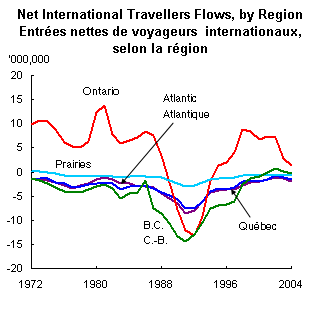
At the same time, Ontarians increasingly favoured more exotic destinations. In 2004, nearly 3 million of them went overseas, twice their number in 1991 and three times more than in the 1980s. Meanwhile, overseas travel to Ontario stagnated after the 1980s, as foreign visitors increasingly preferred the West.
Quebec travellers are the least likely to go south. In 2003, 79% of trips by Quebeckers were to the US, the smallest share of any region. Travel by Quebeckers south of border has declined steadily from 1991. Cross-border shopping by Quebec represents just 8% of the Canada total.
Figure 6b
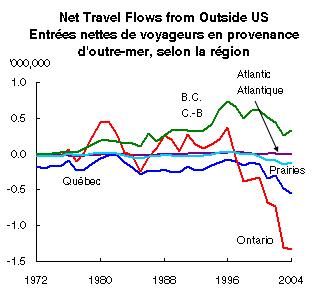
As a result, Quebec has been less affected by fluctuations in the exchange rate and cross-border shopping. Like with the rest of Canada, fewer Americans have visited in recent years. However, Quebeckers also travel less to the US, leaving the overall balance little changed since 1991. Quebeckers made 1 million more trips than they hosted in 2004, 6 million less than in 1991.
But an even more fundamental change for Quebec has occurred in overseas travel, where the net outflow has accelerated since 1972. Travel overseas grew 63%, a rate of increase that was second only to the 97% gain posted by Ontario. Meanwhile, 17% more overseas visitors to Canada headed to Quebec, compared with a decline for Ontario.
Figure 7
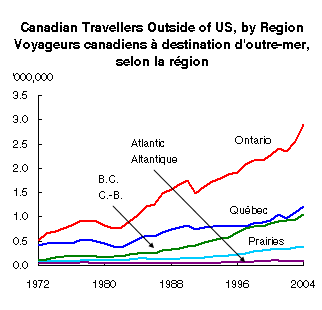
The travel balance for the Atlantic region has shown the least improvement. Almost 2 million more people left this region on trips than came to visit. While well below the record gap of 8.5 million people in 1991, this remains a considerable shortfall for a region of just 2.3 million residents.
As in the case of Ontario, travel by Atlantic residents is almost synonymous with travel to the US. In 2004, 98% of travellers from the Atlantic provinces went south of the border, a share that has fallen only slightly from 99.5% in 1992. Residents of this region have returned to cross-border shopping more than any other region since 2002, while the number of visitors from the US has fallen.
Figure 8a
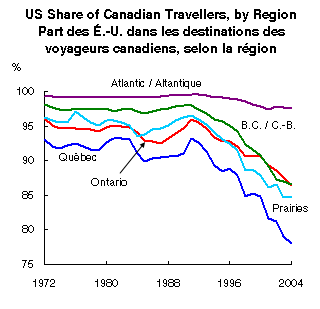
Figure 8b

Recent feature articles
|


































